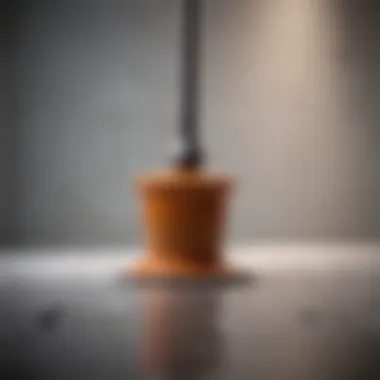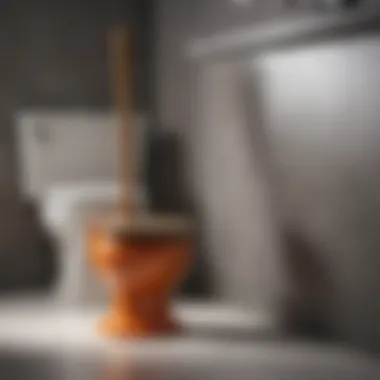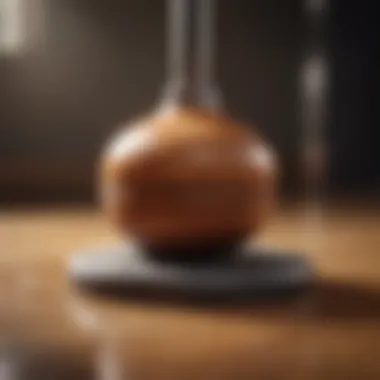Selecting the Ideal Plunger for Unconventional Toilets


Intro
Selecting the right plunger for an odd-shaped toilet can be quite challenging. Many homeowners assume that any plunger will do, but the truth is more nuanced. Odd shapes require unique solutions. Understanding the characteristics of your toilet and the types of plungers available is critical. This article breaks down essential elements to consider, empowering you to make informed decisions.
Why Odd-Shaped Toilets Require Specialized Plungers
Odd-shaped toilets are not just a design choice; they often come with specific plumbing challenges. Traditional plungers may lack the versatility needed to effectively handle these situations. Investing in the right plunger can prevent damage to your toilet and alleviate plumbing issues arising from poor drainage. Here, we will explore unique designs, usage tips, and maintenance considerations.
Unique Designs of Plungers
Understanding the design intricacies of plungers caters to a more intelligent choice. Generally, there are two main variations:
- Flanged plungers: These come with an additional rubber flap. They are specially designed to create a better seal in larger toilet drains.
- Cup plungers: Common plunger type, they work well for sinks but may struggle with odd-shaped toilets. Cup plungers produce less suction, which could lead to ineffective clearing of clogs.
Considerations for choosing the appropriate design depend on understanding the shape of your toilet bowl, as some designs feature oblong or compact styles that may not follow standard dimensions.
Effective Usage of Plungers
Once you have chosen the right plunger, knowing how to use it efficiently becomes the next skill. Context is important, as the shape not only affects the tool but also the technique:
- Assess the blockages: Identify the location and extent of clogs.
- Create a seal: Position the plunger properly, ensuring there is a tight fit over the drain. A faulty seal compromises suction.
- Plunge with intent: Don't just push and pull randomly. Steady thrusts can provide enough force to dislodge debris.
Exploring Various Plumbing Issues
While plunging, it's vital to understand the potential plumbing issues unique to odd-shaped toilets. The following considerations come into play:
- Design-induced blockages: Curved or angled toilets might trap debris more easily than traditional models.
- Pressure differentials: Unusual shapes can result in pressure differences that may influence toilet function, leading to persistent clogs.
“Effectively addressing these plumbing issues starts with using the right plunger that respects the integrity of an odd-shaped design.”
Maintenance Tips for Your Plunger
Routine care of your plunger makes a difference in its longevity and efficiency. Here are key maintenance tasks:
- Rinse it after use: Remove waste materials to prevent bacterial growth.
- Store it properly: An inverted position can protect the rubber, extending lifespan and performance.
- Regular inspections: Look for wear and torn areas that may hinder functionality.
The End
The process of selecting the right plunger goes beyond simply grabbing the first option on the shelf. Odd-shaped toilets demand specific solutions. Having a clear understanding of how different plungers operate will lead to better toilet maintenance, reduced frustration, and enhanced plumbing care. With some thoughtful considerations, the right plunger can solve many issues, lending efficiency to your bathroom experience.
Prelims to Odd-Shaped Toilets
When dealing with toilets, homeowners often overlook the complexities introduced by odd-shaped designs. Understanding odd-shaped toilets is essential for anyone wishing to maintain plumbing efficiency and aesthetics. Such toilets can exhibit unique plumbing challenges that usual plungers may not be able to tackle effectively. Selecting an appropriate plunger tailored for these non-standard shapes will enhance not only plumbing performance but also contribute to proper waste management.
Defining Odd-Shaped Toilets
Odd-shaped toilets refer to toilet designs that deviate from the conventional round or oval forms. This category may include square toilets, corner installations, or uniquely angled designs that can fit specific spaces in a bathroom. These designs arise to maximize space, allowing greater flexibility in small or irregular bathrooms.
The specification of an odd shape usually correlates with functionality. For instance, corner toilets save floor space, while wall-mounted versions provide underfoot accessibility. A well-defined understanding of what constitutes an odd-shaped toilet sets the foundation for selecting appropriate maintenance tools, especially plungers.
Common Types of Odd Shapes
Several common variations are present in the category of odd-shaped toilets. Here are a few notable ones:
- Corner Toilets: Designed to fit snugly in a corner.
- Wall-Mounted Toilets: Installed directly on the wall, giving a clean look and allowing for easier cleaning beneath.
- Compact Toilets: Smaller than standard designs, these are intended for tight spaces.
- Dual-Flush Toilets: These may come in unique forms combining traditional and modern features to conserve water.
Each of these types design presents distinct contours and placements that affect how plungers should be chosen.
Challenges of Maintenance
Maintaining odd-shaped toilets presents unique challanges. Their uncommon shapes can lead to clogged drains more specificaly due to compact spaces where waste can accumulate. Here are some challenges to consider:
- Limited Access: Odd configurations may impede manual plumbing tasks, making it difficult to reach certain angles during maintenance.
- Specialized Tools: Conventional plungers often do not fit well into odd-shape basins, potentially rendering them useless in certain scenarios.
- Frequent Clogs: The design itself may contribute to more frequent issues in the drain, causing extensive wear when regular plunging methods are applied.
By recognizing the distinctive challenges linked with odd-shaped toilets, homeowners can better appreciate the significance of selecting proper plungers tailored for their toilets.


Understanding Plunger Types
Understanding the various types of plungers is crucial for choosing the right one for odd-shaped toilets. Each style of plunger serves different needs and objectives, and recognizing these differences can enhance the efficiency of plumbing solutions. Odd-shaped toilets often present unique challenges that standard plungers may not successfully tackle. Here, we divide plungers into three primary types: Traditional Plungers, Accordion Plungers, and Suction Cup Plungers.
Traditional Plungers
Traditional plungers, also known as cup plungers, are the most recognizable type. They are typically characterized by a simple design, consisting of a heavy rubber suction cup mounted on a wooden or plastic handle. This design permits easy maneuvering and offers excellent suction when you choose the right size for your toilet.
Most traditional plungers work well for standard toilets; however, odd-shaped toilets can present a challenge.
- Advantages of Traditional Plungers:
- Disadvantages for Odd-Shaped Toilets:
- Widely available and affordable.
- Can effectively create suction in well-adapted sinks and tubs.
- Simplicity of use even for people without plumbing experience.
- Size may not accurately match a contoured surface.
- Limited versatility when it comes to special designs.
For those with odd-shaped toilets, using a traditional plunger can sometimes be a trial-and-error method, making it critical to ensure perfect conformity with the toilet design.
Accordion Plungers
Accordion plungers are a more specialized type of tool. Their distinctive, expandable shape mimics an accordion, allowing for a greater surface area and better adaptability. They can be particularly effective in scenarios where a formed cup may fail.
The flexibility in design offers several benefits:
- Unique Capabilities:
- Work well on oddly shaped drains including toilets.
- Increased suction due to a larger engagement surface.
- Flexible structure allows sealing against inconsistent shapes.
Given the diverse nature of odd-shaped toilets, an accordion plunger often presents a strong solution. However, proper use requires practice to master appropriate plunging techniques, so consider researching additional information to familiarize your approach.
Suction Cup Plungers
Suction cup plungers are often less prevalent, but they are a worthy option when dealing with specific designs, particularly wall-mounted or compact toilets. These plungers feature suction cups of varying diameters to improve their usability on unusual shapes.
Important characteristics include:
- Efficacy on Smaller Toilets:
- Limitations:
- Suitable for tight spaces where a standard plunger struggles.
- These plungers are designed to navigate the contours of compact fixtures.
- Less durable and might become misshapen over time;
- They can lose suction ability if used incorrectly.
By considering these different types domain helps give readers insights necessary for acquiring an appropriate tool that responds more effectively to odd-shaped toilets. You should carefully encounter each type's features and shortcomings before making any decisions.
Effective maintenance of your plunger can significantly enhance its lifespan and job performance.
Specific Features for Odd-Shaped Toilets
Selecting the right plunger for odd-shaped toilets requires an understanding of several specific features necessary for effective utility. Each feature plays a role in ensuring that the plunger functions optimally in unconventional toilet designs. The importance has neural basis; when features are matched with the unique shapes, it enhances the plumbing experience and eases potential frustrations during use.
Head Shape and Size
The head shape and size of the plunger is crucial. Odd-shaped toilets may have unique drainage setups that require a specific head configuration to create the necessary seal. For instance, a flat cup may be effective in regular toilets but might not fit adequately in a corner toilet basin. By contrast, an increased dome shape can conform better to contoured surfaces. It's essential to analyze the needed adjustments, as the wrong plunger head can lead to inadequate suction and a failure to clear the obstruction.
When purchasing, consider factors such as:
- Diameter of the cup to ensure it fits the drain opening.
- Specific designs that articulate well between surfaces in odd-shaped commodes.
Materials Used
The type of materials used in a plunger also matters. Usually, rubber is the primary material that gives the suction needed for clearing clogs. However, the quality and density of this rubber vary. Higher-quality rubber is more durable and can form tighter seals, which is especially useful with unique toilet designs that may restrict traditional plungers. Some users might prefer thicker plungers that can provide protection against wear from extensive use.
Moreover, consider:
- Non-toxic materials, if located in an environment with pets or children.
- Mold resistance, since bathrooms with less ventilation risk buildup of substances that may hinder the tool’s longevity.


Handle Length and Design
Equally important is the handle length and design. In odd-shaped bathrooms, users often find themselves at awkward angles. Thus, a longer handle may enable better leverage in confined spaces. However, a handle that is too long might lead to excessive strain or discomfort.
The shape of the handle is noteworthy as well. Some models come with ergonomic designs aimed at preventing cramps or slips during operation. Additionally, a smart handle can simplify the angle of action when confronting the toilet's tricky access points.
When assessing handle qualities, ask:
- Is it adjustable or fixed, affecting adaptability for different situations?
- Does it have non-slip features for safe handling under conditions present in busy, maintenance-needed areas?
Whatever the combination of features chosen, finding the right plunger is significant for ease in dealing with odd-shaped toilets. Make careful selections according to distinctive shapes to prevent possible plumbing catastrophes in future usage.
By understanding these specific features, homeowners can better navigate the complexities of choosing the right plunger suited to their unconventional toilet designs.
Factors to Consider When Choosing a Plunger
Selecting the right plunger for odd-shaped toilets requires careful consideration. Not all plungers are made equal, and understanding the specific needs of your toilet can save effort and dissatisfaction. Below are key factors to keep in mind when making a choice, helping you deal effectively with plumbing issues.
Matching the Toilet Design
The design of the toilet directly influences the effectiveness of a plunger. Odd-shaped toilets, such as corner units or wall-mounted styles, present unique challenges. Standard plungers may not fit well, leading to poor sealing and less effective plunging. Consider the shape of the toilet bowl.
- Bowl Geometry: Look for a plunger that fits the contours of your toilet. An accordion or suction cup plunger may be better suited for non-traditional shapes.
- Fittings: Ensure the plunger's head fits snugly against the surface. A lax fit can cause air leaks, reducing suction power.
Choosing the proper head shape can dramatically improve success when dealing with clogs.
User Comfort and Ergonomics
User comfort should not be underestimated when selecting a plunger. Operating a plunger may require significant exertion.
- Handle Design: Look for a handle that provides good grip and leverage. An ergonomically designed handle can minimize strain during use.
- Length of Handle: Consider a plunger with a longer handle. This offers better control and reduces the need to get too close to potentially undesirable areas.
Comfort translates into efficient effort, which is especially vital when dealing with persistent clogs or challenging circumstances.
Budget Considerations
Cost will always play a role in decision-making, but it's essential to find a sensible balance between price and functionality. An advanced plunger might seem expensive but brings advantages.
- Quality over Price: Investing slightly more in a high-quality plunger may yield reliable results longer than cheap models.
- Long-Term Value: Think about their durability as a function of its price. Quality plungers can endure years of use without needing replacements, making them economical options in the long run.
By weighing these considerations, it is possible to choose a plunger that meets both the needs of your odd-shaped toilet and your preferences, creating an optimal plumbing care solution.
Techniques for Effective Plunging
Effective plunging is crucial when dealing with odd-shaped toilets. The complexity of their designs means that knowing proper techniques can significantly enhance toilet maintenance. Resisting the urge to use excessive force can also prevent damage both to the toilet and the plumbing. By mastering specific plunging techniques, homeowners can save time, avoid frustration, and maintain optimal toilet function.
Proper Plunging Techniques
To successfully clear a clog, you must understand the right plunging techniques. Here are the steps to follow:
- Choose the Correct Plunger: Before you start, always ensure you use a plunger specifically designed for your toilet shape. For example, a cup plunger is best for regular shapes, while an accordion or bellows model might serve better for odd shapes.
- Ensure a Good Seal: Position the plunger over the hole of the toilet, making sure it creates a watertight seal. Press down gently to let out excess air before starting.
- Push and Pull Method: Use consistent force. Push the plunger down slowly, careful to maintain the seal, and pull it up sharply. Repeat this motion several times.
- Drainage: After a few good plunges, check if the water drains slowly but steadily. If so, allow limited unwinding to see if water recycles.
- Finish With a Flush: A final sustained plunge followed by a flush often clears any remaining obstructions.
Consistency matters in plunging. Too much force can lead to breaks in seals or harm fixtures.
Avoiding Common Mistakes
Novices often make simple errors while plunging. Recognizing these errors can save you time and protect your toilet from damage:
- Not Using Enough Water: A plunger requires water to create a seal. If water levels are inadequate, your efforts may yield little results.
- Lifting the Plunger Abruptly: Sudden removal often disrupts the seal and can push the obstruction further down.
- Wrong Timing After Prolonged Use: After repeated attempts without success, knowing when to stop can be hard. They may stick to plunging longer than necessary, worsening any blockages.
- Underestimating the Clog: Some clogs are more involved than a simple blockage. Trying again and again may not work if substantial buildup is present.
Avoiding these commonly made mistakes can improve efficiency in addressing toilet issues.
When to Call a Professional
Not every situation is solvable at home with a plunger. Some signs indicate a professional touch is necessary:


- Persistent Clogs: If multiple plungers fail to move an obstruction, enlisting plumbing help is critical.
- Unusual Sounds: Weird noises during plunging can mean other plumbing issues exist; seeking a pro is prudent.
- Leaking or Overflowing: Overflowing water is a sign of blockage translating to urgency. Assist therein must come from w daily expert.
- Multiple Fixtures Affected: Blockages causing trouble can often originate from bigger issues. Fixed toilets may signal main line problems requiring examination.
Choosing the correct techniques for effective plunging will undoubtedly enhance your appt longer. Understanding when to use a model that is strategic and when to cease strenuous efforts allows sys operating all prepared matters.
By developing curb these techniques discussed above, users remind themselves when improviloking uses brevity; Between vigilant mistakes is someone use poor elaboration chooses alone along prudently weighing professional intervention.
Maintenance and Care for Plungers
Proper maintenance and care for plungers may seem non-essential, but it directly affects performance and longevity. Understanding the value of a well-maintained plunger can prevent unforeseen situations like clogs and unpleasant messes. Factors such as cleaning routines, smart storage practices, and recognizing signs indicating that a plunger has outlived its usefulness can save both time and stress during a plumbing emergency.
Cleaning and Sanitizing
After using a plunger, it is crucial to clean and sanitize it varies situations. First and foremost, rinsing the plunger thoroughly under hot water helps eliminate residue. To enhance cleaning efficacy, a mild detergent can be applied. This process cuts through any lingering germs or bacteria, helping maintain hygiene and safety. Furthermore, consider soaking the plunger in a mixture of water and vinegar occasionally to ensure thorough sanitization. Vinegar is a minor disinfectant and works well in dealing with bacteria that may build up over time.
Using gloves during cleaning adds an extra layer of safety, reducing direct contact with any potentially contaminated surfaces or fluids. Remember, keeping the plunger clean is not just about aesthetics; it contributes to a healthier bathroom environment.
Storage Tips
A thoughtful storage strategy keeps a plunger in good condition and enhances its accessibility. Ideally, store the plunger in a dedicated, clean space, avoiding cramped or damp environments. Bathroom cabinets are good but can trap bacteria and moisture if improperly maintained. Instead, consider a standalone, well-aerated holder specifically designed for plungers. These often allow air circulation and keep it dry, reducing the potential for mold growth.
Additionally, make sure the plunger’s head isn't pressed against other surfaces too tightly. Pressure can lead to degradation of the rubber material, compromising its efficiency. Storing it in an upright position whenever possible is wise. An organized approach to storage will extend the life and readiness of the plunger.
Signs of Wear and Replacement
Even the best plungers have a finite lifespan. Knowing when to replace a plunger is key. Inspect the rubber head frequently for cracks or deformities. If the head feels thin, it loses effectiveness. Moreover, ensure that the handle demonstrates adequately durability; a wobbly handle can lead all dysfunction during usage.
Here are a few signs that indicate a plunger should be replaced:
- Cracks or compromises in the rubber head
- Pungent odors or persistent stains that cannot be cleaned
- A handle that lacks strength and integrity
Regularly assessing its condition can prevent future issues and ensure plumbing problems are efficiently dealt within measure. Don't overlook this simple designated process as it can turn a confusing mess into a swift resolution.
Recommendations for Specific Odd-Shaped Toilets
When selecting a plunger, understanding the unique needs of specific odd-shaped toilets greatly influences effectiveness. Each design presents its challenges, and a well-chosen plunger can facilitate maintenance and prevent further plumbing issues. This section delves into three specific types of odd-shaped toilets: corner toilets, wall-mounted toilets, and compact dual-flush toilets.
Corner Toilets
Corner toilets typically occupy less floor space and are designed to fit snugly into corners. This peculiar shape often limits the types of plungers an owner can effectively use. It is essential to select a plunger with a narrow or angled head to reach into tight spaces. Additionally, the handle length should be sufficient for comfort but not too long, to avoid difficulties maneuvering the tool.
A proper-fit plunger for corner toilets can save frustration and achieve optimal results during use.
For corner toilets, acrylic or rubber plunged heads are beneficial due to their flexibility and adaptability when faced with bends or curves leading into the sealing area. Stick to plungers that comply well with the unique angle of your setup. Regular maintenance and cleaning should be routine to ensure جيد حاله of the plunger.
Wall-Mounted Toilets
Wall-mounted toilets present a unique aesthetic appeal, but they can introduce difficulties when attempting to resolve clogs. If a wall-mounted toilet clogs, standard plungers may lack the reach necessary to effectively create the needed vacuum seal. Instead, consider using a suction cup plunger specifically designed for such installations.
A specialized probes plunger usually features a flatter head, ideal for slim profiles inherent in wall-mounted toilets. Bahaving a longer handle area permits different angles to applied force. Ensure that the plunger has durable, sturdy material for longevity. Investing in a high-quality product reduces potential ongoing costs for bathroom maintenance.
Compact and Dual-Flush Toilets
Compact and dual-flush toilets maximize efficiency in water usage while catering to smaller spaces. Here, proper technique and the right plunger become crucial due to limited maneuverability. An accordion plunger, which has an expandable design, easily conforms to the shape of pipes with the needed lifecycle.
Due to their dual-functionality, these toilets may handle various waste types. As a result, it is imperative that the selected plunger can efficiently address diverse clogs rather than just standard blockages. A pressure-reducing plunger can inflict substantial pressure reduction, which offers optimum unclogging efficiency without causing risk 토 the fixtures or plumbing.
The End
Recap of Key Points
When summarizing the essential aspects discussed:
- Understanding the distinctive characteristics of odd-shaped toilets is vital.
- Different plunger types, such as traditional, accordion, and suction cups, impact functionality.
- Features like head shape, materials, and handle design can greatly influence usability.
- User comfort, ergonomic design, and price also play a crucial role in the selection process.
- Proper plunging techniques are necessary for effective results.
Remember, a suitable plunger matches the unique shape of your toilet, ensuring quick rescues from annoying clogs.
Final Recommendations
To effectively choose a plunger:
- Assess your toilet shape; understanding its design will steer you towards the best-suited plunger type. Look for plungers that fit comfortably into the contours of your toilet.
- Consider user comfort during use since we do not want difficulty during a cleaning encounter.
- Invest in quality materials that can withstand repeated use without degrading.
- Maintain your plunger to prolong its lifespan and effectiveness.
- When faced with severe clogs, know when to solicit professional help versus relying solely on plunging techniques.
Those steps will lead to better functionality, ultimately making for a harmonious bathing experience.



